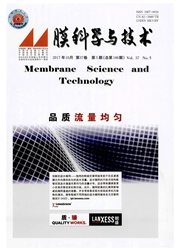

 中文摘要:
中文摘要:
采用Osmonics的DK和DL纳滤膜对抗生素制药废水进行深度处理.对纳滤膜污染的影响因素进行了考察.结果表明,在相同条件下,DK膜的通量随时间的下降幅度小于DL膜,截留率大于DL膜.随着溶质浓度或溶液温度的升高,纳滤膜的通量下降幅度增大,截留率增大.采用ATR—FTIR及EDX分析膜面污染物质,并结合水质分析结果可知,3h纳滤过程中引起膜污染的主要物质是硫酸钙、碳酸钙等无机物.为了控制膜污染,考察了在原料液中添加药剂对膜污染的影响.结果表明,添加盐酸或柠檬酸能使膜通量下降减缓,却使截留率降低;添加EDTA能使膜通量下降减缓,并使截留率增大.添加药剂后,膜面污染物的红外吸收峰被削弱,钙、硫和氧元素的质量百分比降低.其中添加EDTA后,膜面红外谱图及元素组成与清洁膜最接近.
 英文摘要:
英文摘要:
The Osmonics DK and DL nanofiltration membranes were used for advanced treatment of antibiotic pharmaceutical wastewater. The effects of some factors on membrane fouling were investigated. The results showed that under the same testing conditions, compared with DL membrane, DK membrane had lower flux decline and higher rejection. With increasing feed solute concentration or solution temperature, both the flux declines and the rejections of the NF membranes increased. The foulants on membrane surface were analyzed by ATR - F-FIR and EDX. Combining these analysis results with the feed water quality, it was found that the foulants were mainly inorganic matters such as CaSO4 and CaCO3 after 3 h nanofiltration. In order to reduce fouling, proper reagents were added to NF feed, and the effects of them on membrane fouling were investigated. The results showed that after addition of hydrochloric acid or citric acid to the feed, the flux decline was slowed down, but the rejection decreased. After addition of EDTA, both the flux and the rejection of the NF membranes were improved, i. e. , the lower flux decline and the higher rejection were obtained. It was also found that after addition of the reagent hydrochloric acid, citric acid or EDTA, the IR bands for the foulants were weakened, the mass percents of elements Ca, S and O were decreased. After addition of EDTA, the membrane IR spectrum and element contents was closest to that of the cleaned original membrane.
 同期刊论文项目
同期刊论文项目
 同项目期刊论文
同项目期刊论文
 A novel method of surface modification on thin-film-composite reverse osmosis membrane by grafting h
A novel method of surface modification on thin-film-composite reverse osmosis membrane by grafting h Advanced treatment of a complex pharmaceutical wastewater by nanofiltration: Membrane foulant identi
Advanced treatment of a complex pharmaceutical wastewater by nanofiltration: Membrane foulant identi 期刊信息
期刊信息
